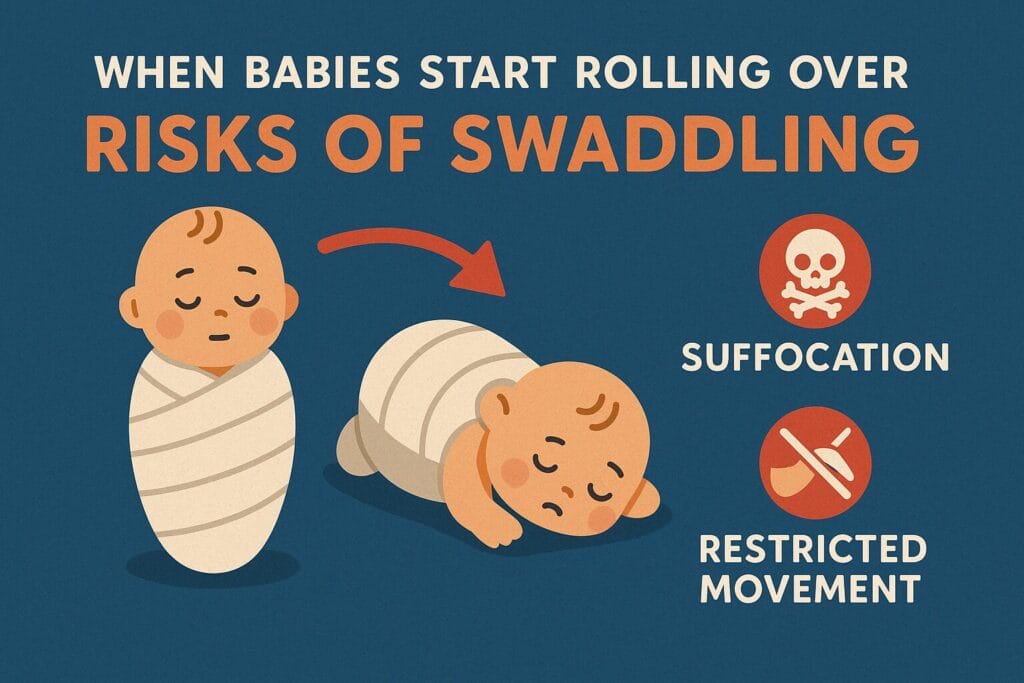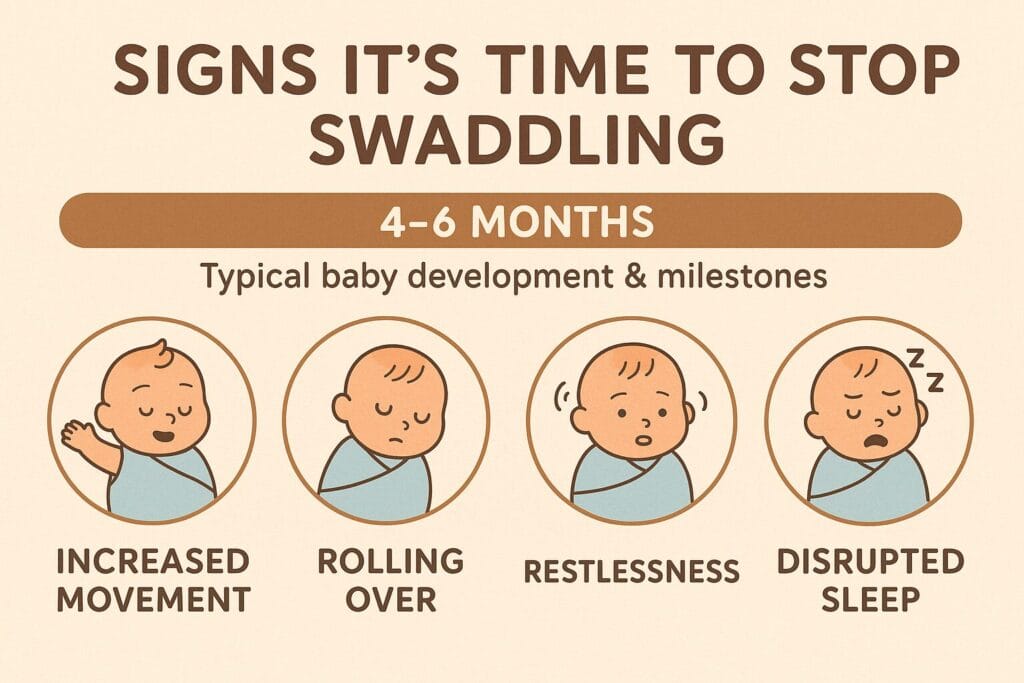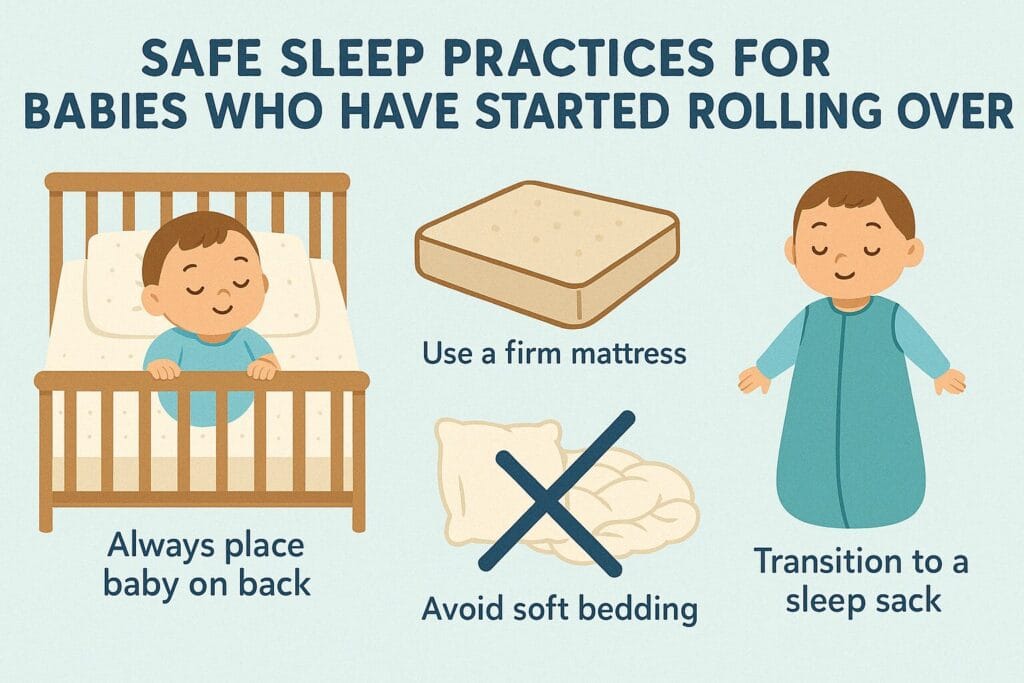For new parents, the struggle to get their baby to sleep is often one of the toughest challenges. Swaddling has long been a popular method to help babies feel secure and fall asleep. However, a situation can arise where a baby won’t sleep without swaddle but rolls over, creating a mix of safety concerns and sleepless nights. Many parents are unsure what to do when their baby is no longer safe in the swaddle but insists on being swaddled to sleep.
In this article, we will explore the issue of swaddling and rolling, discussing why a baby won’t sleep without swaddle but rolls over can be dangerous, how to transition your baby safely, and provide helpful advice on ensuring your baby continues to sleep peacefully. We will delve deep into the necessary steps, sleep safety guidelines, and tips on how to navigate the transition for a safe and restful sleep for both parents and baby.
Table of Contents
Why Swaddling Isn’t Safe When Your Baby Rolls Over

Swaddling has long been an essential tool for soothing babies. It provides them with the sense of security and comfort they experienced in the womb. Many parents rely on swaddling to help their newborns sleep better by preventing the startle reflex (Moro reflex), which can wake babies up from sleep. The snugness of a swaddle helps babies feel secure and warm, often making it easier for them to drift into a peaceful slumber.
However, the situation changes when a baby won’t sleep without swaddle but rolls over. While swaddling works well for newborns who aren’t yet mobile, the dynamics shift dramatically once a baby begins to roll over. When your baby starts rolling, swaddling can become not just ineffective but dangerous. The baby won’t sleep without swaddle but rolls over scenario presents significant safety risks that need to be addressed immediately to ensure your baby’s well-being during sleep.
Swaddling is a practice that helps many babies sleep through the night, but once a baby begins showing signs of rolling over, parents must be vigilant. If you find yourself in a situation where your baby won’t sleep without swaddle but rolls over, it’s essential to understand the risks involved and take the necessary steps to transition your baby to a safer sleep environment. Let’s dive into the key dangers of swaddling a baby who won’t sleep without swaddle but rolls over.
The Risks of Swaddling a Baby Who Rolls Over

When your baby won’t sleep without swaddle but rolls over, the risks of suffocation, restricted movement, and even increased chances of SIDS (Sudden Infant Death Syndrome) all come into play. These risks make it crucial to stop swaddling as soon as your baby begins to show signs of rolling over. Here are the main concerns:
Suffocation Risk
The most significant danger associated with swaddling a baby who won’t sleep without swaddle but rolls over is suffocation. When a baby rolls over while swaddled, they can end up on their stomach, a position that greatly increases the risk of suffocation. This is particularly dangerous because a swaddled baby may not have the ability to lift their head or adjust their position. In a swaddle, babies are confined, making it much more difficult to reposition themselves in case they end up in an unsafe sleeping position.
If a baby won’t sleep without swaddle but rolls over, and ends up on their stomach, they are unable to move freely to turn their head or reposition their body. As a result, they may struggle to get the necessary airflow, which can ultimately lead to suffocation. This is a serious safety concern, and it is why parents must immediately stop swaddling once their baby shows signs of rolling over.
Restricted Movement
Swaddling is designed to restrict a baby’s arm and leg movement, creating a cozy environment that resembles the womb. While this is beneficial for newborns who have not yet developed motor skills, it becomes problematic when a baby won’t sleep without swaddle but rolls over. Babies need to have the ability to move freely as they grow and develop. Once they start rolling over, they need to be able to adjust their body position during sleep. A baby who won’t sleep without swaddle but rolls over needs freedom to move their arms and legs so they can shift into a safer position if necessary.
Swaddling restricts these movements, which can lead to frustration and discomfort. When a baby is swaddled and unable to move freely, they may become upset or wake up more frequently. This restriction of movement becomes even more problematic if the baby won’t sleep without swaddle but rolls over, as the baby may find themselves unable to reposition their body safely, making it more difficult for them to get back to a comfortable sleeping position.
Increased Risk of SIDS (Sudden Infant Death Syndrome)
The risk of Sudden Infant Death Syndrome (SIDS) increases when a baby is swaddled and unable to move freely, particularly once they begin showing signs of rolling over. The American Academy of Pediatrics (AAP) advises parents to always place their babies on their backs to sleep, as this position has been shown to reduce the risk of SIDS. However, when a baby won’t sleep without swaddle but rolls over, swaddling prevents them from being able to move freely if they end up in an unsafe position.
The baby won’t sleep without swaddle but rolls over issue poses a risk because, once a baby is able to roll, they should be able to reposition themselves if they end up on their stomach. Swaddling, however, keeps them confined and unable to adjust their position, which could lead to suffocation or an increased risk of SIDS. It’s vital for parents to be aware of the risks and to transition out of swaddling as soon as their baby shows signs of rolling over.
Why You Need to Stop Swaddling Once Your Baby Can Roll Over
If your baby won’t sleep without swaddle but rolls over, it’s time to act quickly to ensure their safety. Swaddling must stop once your baby is able to roll, as the risks associated with rolling over while swaddled outweigh the benefits. While it can be hard for both you and your baby to transition away from swaddling, this change is necessary for their safety and well-being.
The Immediate Need for Change
The baby won’t sleep without swaddle but rolls over scenario is a common concern, but it also represents a critical moment in your baby’s development. As babies develop new motor skills, such as rolling, they also become more mobile, which means they need to be able to move freely in their sleep space. A swaddle, which has been a source of comfort and security up until this point, is no longer safe when rolling becomes a part of their development.
If you continue swaddling a baby who won’t sleep without swaddle but rolls over, the risks of suffocation and restricted movement will increase significantly. These dangers make it crucial to stop swaddling immediately and to start looking into safer alternatives to help your baby sleep peacefully.
Transitioning to Safer Sleep Practices
To avoid the risks associated with swaddling once your baby won’t sleep without swaddle but rolls over, it’s important to begin the transition to safer sleep habits. Start by considering alternatives like sleep sacks, which are designed to provide the warmth and security of a swaddle while still allowing for movement. Other methods, such as gradually phasing out the swaddle or using the “one arm out” technique, can help ease your baby into a new sleep routine without disrupting their comfort.
In conclusion, swaddling can no longer be considered a safe sleep practice once a baby won’t sleep without swaddle but rolls over. The transition to a safer sleep method is crucial to ensure your baby’s safety, comfort, and restful sleep. Be sure to monitor your baby’s development closely and respond appropriately when they begin rolling over. By doing so, you’ll help your baby maintain healthy sleep patterns while keeping them safe from potential hazards.
When to Stop Swaddling and How to Recognize It

The decision to stop swaddling comes when your baby won’t sleep without swaddle but rolls over, signaling the need to move to a safer sleep routine. This transition often happens between 4 and 6 months of age when babies begin gaining enough strength to roll over.
Signs That Your Baby is Ready to Transition from Swaddle
When a baby won’t sleep without swaddle but rolls over, it’s essential to know the signs that indicate it’s time to stop swaddling:
- Baby Starts Rolling Over: As babies start rolling over, either from their back to their stomach or vice versa, they need to be able to move freely. A baby won’t sleep without swaddle but rolls over must be given the ability to roll and shift positions safely.
- Increased Restlessness: If your baby has become more active and is trying to escape the swaddle or is moving around more than usual during sleep, it’s time to think about transitioning them out of the swaddle.
- Sleep Disruptions: If your baby is waking up more often or seems uncomfortable when swaddled, they may be ready for a change. A baby won’t sleep without swaddle but rolls over needs the flexibility to move.
- Motor Skill Development: Babies develop motor skills at different rates. Once your baby has learned to roll over and has better control of their arms and legs, they can no longer be safely swaddled. A baby won’t sleep without swaddle but rolls over requires a safer sleeping environment that accommodates their newfound abilities.
As soon as you notice these signs, it’s time to stop swaddling. The baby won’t sleep without swaddle but rolls over situation is common for many parents, and taking timely action ensures a smoother transition.
Safe Ways to Transition from Swaddle

Transitioning from swaddling when a baby won’t sleep without swaddle but rolls over can feel overwhelming for parents. However, with the right methods, this process can be both safe and effective. Here’s a step-by-step guide to help your baby adjust to sleeping without the swaddle:
1. Gradual Transition: One Arm Out
The gradual transition method is one of the best ways to move away from swaddling. If your baby won’t sleep without swaddle but rolls over, consider using the “one arm out” method. This involves slowly reducing the swaddle’s tightness by leaving one arm free. After a few nights, you can leave both arms out of the swaddle. This process gives your baby the freedom to adjust while still providing some security.
2. Using a Sleep Sack
For a baby who won’t sleep without swaddle but rolls over, a sleep sack is an excellent alternative. Sleep sacks are wearable blankets that provide warmth without restricting arm movement. They allow babies to feel secure and cozy while giving them the freedom to move their arms and legs. Many sleep sacks are designed with features that allow babies to roll over freely while still feeling swaddled in a more breathable and safe way.
3. Swaddle Transition Blankets
Some products are specifically designed for transitioning babies away from swaddling. For instance, Aden + Anais offers transition swaddle blankets that are less restrictive but still provide a comforting sensation. If your baby won’t sleep without swaddle but rolls over, such products are ideal because they allow gradual movement while maintaining a snug fit.
4. Increase Tummy Time
Tummy time is crucial for building the muscles that babies need to roll over safely. When your baby won’t sleep without swaddle but rolls over, ensuring your baby gets plenty of tummy time throughout the day will help them strengthen the muscles needed for safe and comfortable movement during sleep.
Is your baby rolling onto their stomach during sleep but struggling to roll back? Learn what steps you can take to ensure your baby’s safety and comfort. Click here to find expert tips on how to handle this situation!
5. Night time Weaning from the Swaddle
If your baby is used to being swaddled to sleep, gradually weaning them off it can be an effective method. Try swaddling them for only part of the night, reducing the swaddling time over several nights. This can help your baby who won’t sleep without swaddle but rolls over adjust gradually and learn to sleep without being fully swaddled.
Tired of contact naps and looking for a solution? Discover 7 proven tips to help your baby transition and enjoy better sleep for both of you. Click here to find out how!
Safe Sleeping Practices Post-Swaddle

After transitioning your baby out of the swaddle, there are key safe sleeping practices to follow. When a baby won’t sleep without swaddle but rolls over, ensuring their sleep environment is safe becomes even more crucial.
1. Always Place Baby on Their Back to Sleep
When transitioning away from the swaddle, continue to place your baby on their back to sleep. The safest position for your baby to sleep in is on their back, as it minimizes the risk of SIDS. This should be maintained even if your baby won’t sleep without swaddle but rolls over.
Is your newborn rolling to their side while sleeping? Discover 5 essential tips to ensure their safety and help promote peaceful rest. Click here to learn how to keep your baby comfortable and secure during sleep!
2. Keep the Crib Simple and Safe
Make sure your baby’s crib is free from soft bedding, pillows, and stuffed animals. A firm mattress, along with a fitted sheet, is all you need. The simpler the crib, the safer your baby will be. This is particularly important for a baby who won’t sleep without swaddle but rolls over, as a clean, clear sleep environment minimizes the risks of suffocation and other hazards.
3. Avoid Overheating
Overheating is a common issue for babies. To avoid this, dress your baby in appropriate layers. Swaddle alternatives like sleep sacks are great because they provide warmth without overheating. The baby who won’t sleep without swaddle but rolls over may benefit from a breathable, lightweight sleep sack that helps regulate their body temperature.
4. Pacifiers and Sleep Aids
Consider using a pacifier during naps and nighttime sleep. Studies have shown that using a pacifier can help reduce the risk of SIDS, and it provides comfort during the transition from swaddling. If your baby won’t sleep without swaddle but rolls over, a pacifier may help soothe them while they adapt to their new sleep routine.
Dealing with Sleep Regression and Maintaining Consistency
It’s not uncommon for babies to experience sleep regression, especially when transitioning away from swaddling. As your baby won’t sleep without swaddle but rolls over, developmental milestones like rolling and teething can disrupt sleep. Sleep regression is temporary, but consistency is key.
Managing Sleep Regression
- Maintain a Consistent Bedtime Routine: A consistent routine signals to your baby that it’s time to sleep. This might include activities like a warm bath, soft music, or a bedtime story. Consistency is particularly helpful for a baby who won’t sleep without swaddle but rolls over, as they benefit from a predictable environment.
- Comforting Without Picking Up: If your baby wakes up in the middle of the night, try to comfort them without immediately picking them up. Letting them self-soothe is important for their development and helps them adjust to their new sleep routine. The baby who won’t sleep without swaddle but rolls over might need reassurance but also needs to learn how to self-soothe.
- Patience and Flexibility: Sleep regression is usually temporary. If your baby won’t sleep without swaddle but rolls over and wakes up frequently, be patient. Sleep will improve over time as your baby adjusts to the new sleep routine.
Dealing with the 8-week sleep regression? Learn proven strategies to help your baby sleep peacefully again. Click here to explore effective tips for mastering this challenging phase!
FAQS
1. Why is it dangerous for my baby to sleep while swaddled and rolling over?
When your baby won’t sleep without swaddle but rolls over, it’s dangerous because the swaddle restricts your baby’s movement. If your baby rolls over while swaddled, they may not be able to lift their head or adjust their position, leading to an increased risk of suffocation. Swaddling in this situation prevents your baby who won’t sleep without swaddle but rolls over from repositioning themselves, which can be harmful.
2. How do I know when my baby is ready to stop swaddling?
The key sign that your baby won’t sleep without swaddle but rolls over is when they begin rolling. Once your baby starts rolling from their back to their stomach or vice versa, they need more freedom to move. A baby who won’t sleep without swaddle but rolls over should be transitioned to a safer sleep routine as soon as this milestone occurs.
3. My baby seems to need the swaddle to sleep. How can I transition them safely?
If your baby won’t sleep without swaddle but rolls over, the transition can be done gradually. You can start by using the “one arm out” method, where one arm is left free while the other remains swaddled. Over time, you can fully transition your baby who won’t sleep without swaddle but rolls over to a safer alternative, like a sleep sack, which offers comfort while allowing for freedom of movement.
4. How do I transition my baby from a swaddle to a sleep sack?
If your baby won’t sleep without swaddle but rolls over, consider using a sleep sack that offers the snugness of a swaddle but without the risks. A sleep sack lets your baby feel secure while allowing more movement for rolling and shifting positions. Gradually weaning from the swaddle will help your baby who won’t sleep without swaddle but rolls over adjust comfortably to a safer sleep method.
5. Will my baby be able to sleep without the swaddle?
Yes, your baby who won’t sleep without swaddle but rolls over can eventually sleep without it. Though swaddling provides comfort, once your baby has developed motor skills, they need more freedom to move. With the right sleep solutions, like a sleep sack, your baby won’t sleep without swaddle but rolls over will learn to sleep comfortably without the need for swaddling.
6. How long does the transition from swaddle to sleep sack usually take?
The transition from swaddle to sleep sack can vary depending on your baby’s comfort level. If your baby won’t sleep without swaddle but rolls over, expect the transition to take anywhere from a few days to a couple of weeks. Gradually phasing out the swaddle and introducing a sleep sack will help your baby adjust at a pace that works best for them.
7. Is there a risk of SIDS if my baby is swaddled and rolling over?
Yes, when a baby won’t sleep without swaddle but rolls over, the risk of SIDS increases because swaddling prevents your baby from adjusting if they roll onto their stomach. The inability to shift positions while swaddled poses a suffocation risk. Always ensure your baby who won’t sleep without swaddle but rolls over is placed on their back to sleep, and discontinue swaddling once they start rolling.
8. Can I still use a swaddle blanket if my baby is rolling over?
No, once your baby won’t sleep without swaddle but rolls over, using a traditional swaddle blanket is unsafe. If your baby rolls over while swaddled, they won’t be able to move freely. It’s important to switch to safer alternatives like a sleep sack or wearable blanket for your baby who won’t sleep without swaddle but rolls over to allow them the ability to shift positions.
9. What can I do if my baby is waking up more often after transitioning from swaddle?
If your baby won’t sleep without swaddle but rolls over and starts waking more often after transitioning, it’s likely due to the change in sleep routine. Be patient and provide comfort with a consistent bedtime routine. Ensure the sleep environment is safe and cozy for your baby who won’t sleep without swaddle but rolls over. You might also want to check if the new sleep sack or alternative is comfortable enough for them to adjust fully.
10. Is it safe for my baby to sleep on their stomach if they roll over on their own?
Once your baby won’t sleep without swaddle but rolls over, they may begin to roll onto their stomach during sleep. It is not safe for a baby to sleep on their stomach due to suffocation risks. Always place your baby who won’t sleep without swaddle but rolls over on their back to sleep. If they roll over during the night, gently reposition them onto their back to ensure safe sleep practices.
Conclusion: Ensuring Safe and Restful Sleep for Your Baby
When a baby won’t sleep without swaddle but rolls over, it’s crucial to recognize the risks associated with swaddling at this stage of development. While swaddling is an effective tool to help babies sleep soundly in their early months, it becomes unsafe once your baby won’t sleep without swaddle but rolls over. Swaddling restricts movement, making it difficult for your baby to shift positions, especially if they roll over during sleep. This situation can lead to suffocation or discomfort, making it essential to transition to safer sleep practices as soon as possible.
As soon as your baby won’t sleep without swaddle but rolls over, it’s time to take action. Look for signs such as increased restlessness, trying to break free from the swaddle, or frequent waking during sleep. If your baby won’t sleep without swaddle but rolls over, it indicates that they need more freedom of movement, which is crucial for their safety and comfort. Transitioning from swaddling to alternatives like sleep sacks, wearable blankets, or other swaddle alternatives is the key to ensuring that your baby can still feel secure while being able to roll over and adjust their position safely.
The transition away from swaddling can take time, but with a gradual approach, your baby who won’t sleep without swaddle but rolls over will adjust to new sleep habits. This gradual process can include methods like using the “one arm out” technique or introducing a sleep sack, both of which allow your baby to feel secure while moving freely. The goal is to make this transition as smooth as possible, ensuring your baby sleeps safely and comfortably.
Every baby is different, and some may take more time to adjust than others. Patience is key during this period, and ensuring that your baby won’t sleep without swaddle but rolls over has a safe and comfortable sleep environment will help them adapt more easily. With a consistent sleep routine, safe sleep practices, and the right tools, your baby will transition away from swaddling and sleep safely, even after they start rolling over.
Ultimately, as soon as you recognize that your baby won’t sleep without swaddle but rolls over, it’s important to act quickly to ensure their safety. By transitioning to safer sleep alternatives and providing them with more freedom to move, you can help your baby adjust to new sleep habits while ensuring they are comfortable and secure. With the right steps in place, you can rest assured that both you and your baby will get the peaceful sleep you need.



